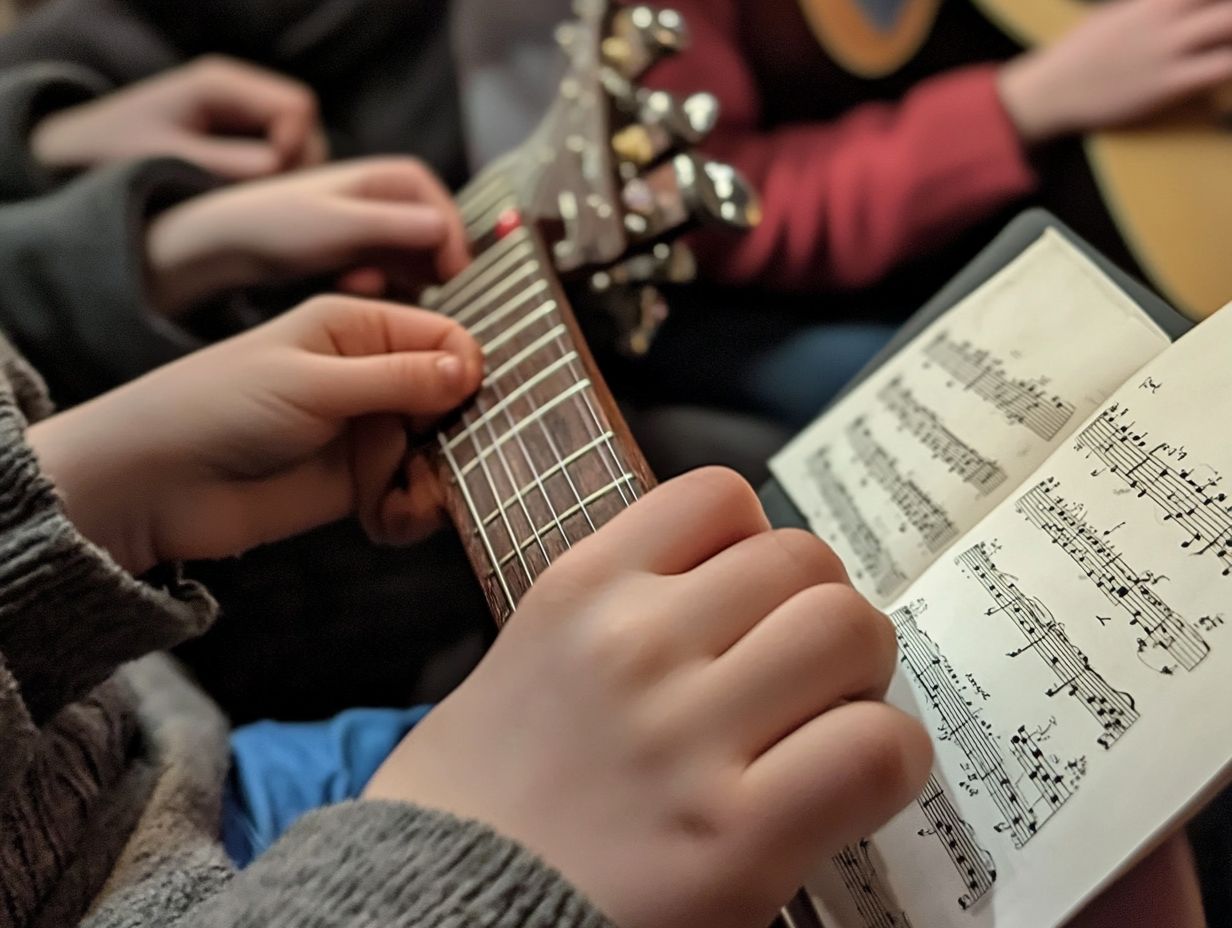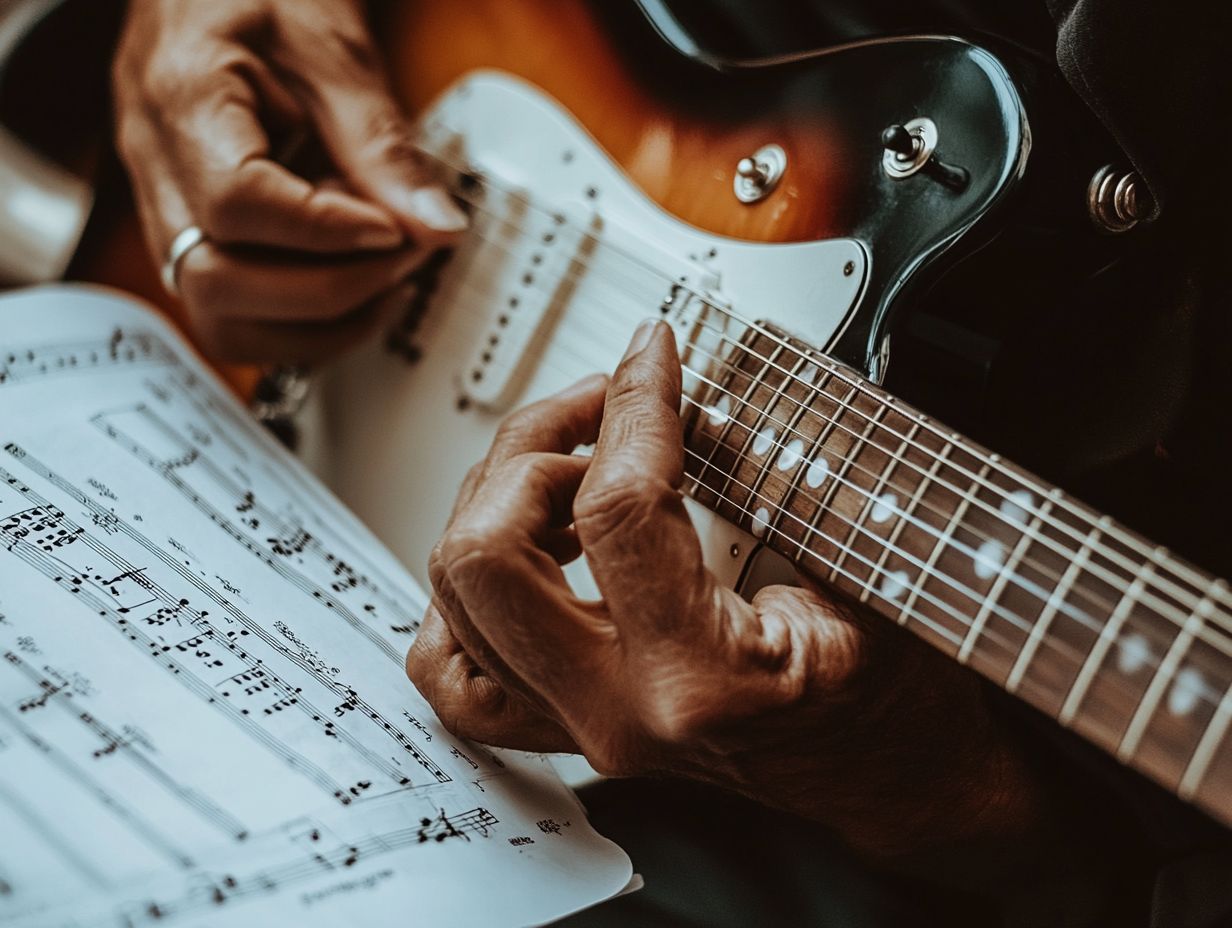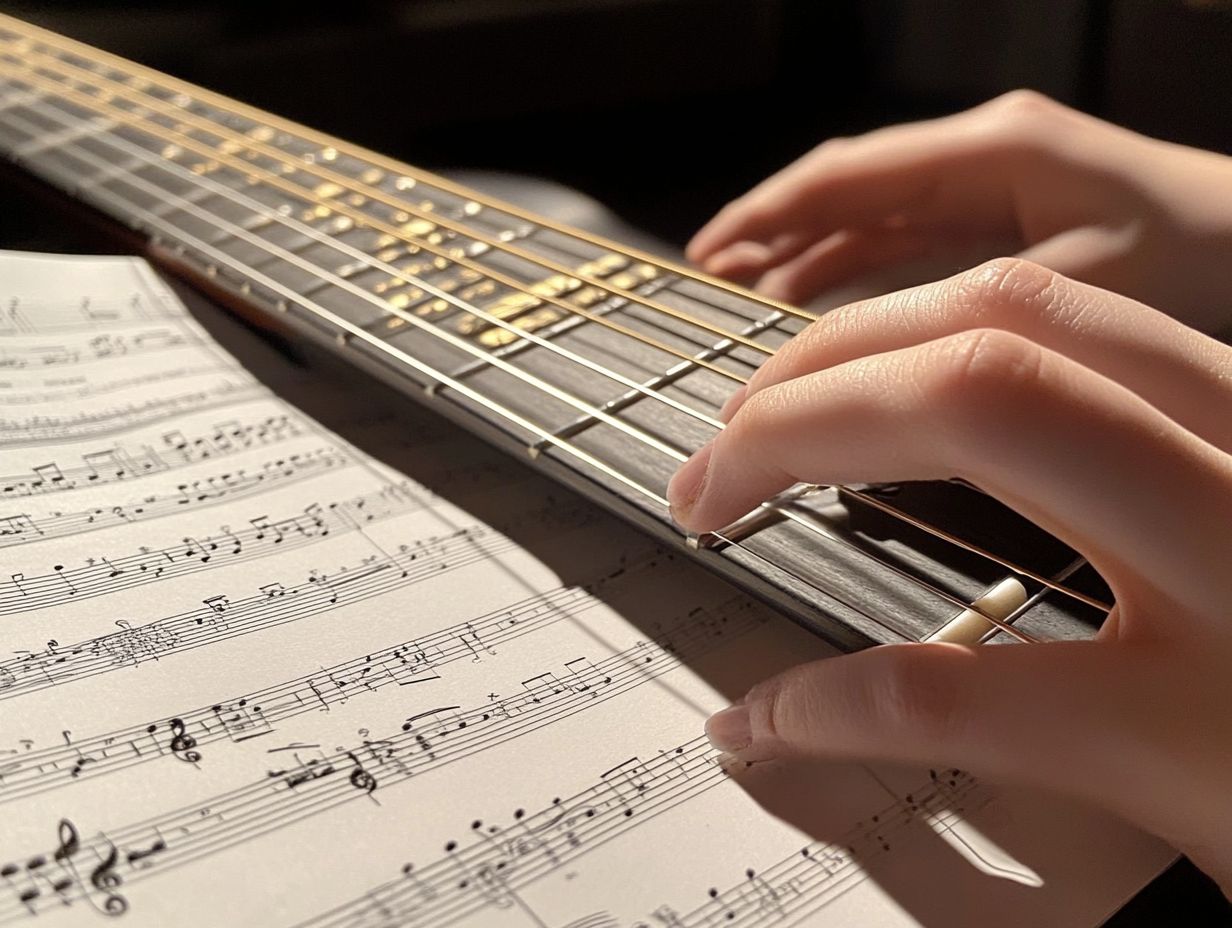This guide provides valuable insights into learning how to play guitar notes. Playing guitar is a rewarding skill that enables you to express your musicality, whether for personal enjoyment or as part of a performance with others. Whether you are a beginner or an intermediate or advanced player seeking to refine your skills, mastering key guitar techniques is essential. This guide covers the fundamentals of finger placement and strumming patterns, as well as more advanced techniques such as bending and vibrato. Additionally, it includes tips for developing an effective practice routine and advice on avoiding common pitfalls. Explore essential techniques and methods whether you’re using an acoustic guitar or electric guitar.
What are Guitar Notes?

Guitar notes are the fundamental building blocks of music, representing specific pitches that can be played on the instrument. This understanding is essential for anyone learning to play the guitar, whether on an acoustic or electric model. Guitar notes correspond to the specific frets on the instrument and can be arranged into various chords and scales, each conveying a unique sound and emotional expression in musical compositions. Familiarity with guitar strings and their tuning methods is crucial in mastering these notes.
The significance of guitar notes extends beyond mere instrument playing. Familiarity with these notes enhances one’s understanding of music theory, making it easier to grasp song structures and engage in improvisation. Beginners often find that recognizing these notes is crucial for developing their musical ear, which significantly impacts their ability to play with others or create their own music. Engaging with learning methods like tablature and music notation is beneficial in this process.
As beginners become proficient in identifying guitar notes, they can explore different chord progressions and scales, granting them greater freedom in improvisation. This knowledge provides a solid foundation, allowing them to experiment with various styles and genres, fostering creativity and a deeper connection to the instrument. Using tools like capos and tuners can further enhance their ability to explore diverse music genres.
A strong grasp of guitar notes unlocks a world of musical possibilities and self-expression.
Basic Techniques for Playing Guitar Notes and Chords
Basic guitar techniques are essential methods that beginners should master in order to play guitar notes effectively. These techniques include the proper positioning of fingers, strumming methods, and the mechanics of playing different notes on the fretboard. Incorporating warm-up exercises and hand coordination drills can significantly enhance learning outcomes.
Mastering these foundational skills is crucial for beginners, as they provide a solid base for future musical endeavors. Furthermore, practicing these techniques will enable beginners to transition smoothly between chords and play melodies, making their journey of learning the guitar more enjoyable and fulfilling. Utilizing online lessons and instructional videos can be an excellent way to supplement practice.
Finger Placement and Strumming

Finger placement and strumming are essential skills that every guitarist must master to play notes effectively. Proper finger positioning on the fretboard ensures clear note production, while an understanding of various strumming patterns allows musicians to create rhythm and dynamics in their playing. Additional techniques like palm muting and fingerstyle can further enhance sound quality.
Both right-hand and left-hand techniques significantly influence how a guitarist produces sound and expresses musical ideas. By concentrating on these aspects, players can enhance their overall performance and develop a unique playing style.
Beginners should start by ensuring that their fingers curve naturally and press down on the strings close to the fret without touching the adjacent strings, which helps produce clean sounds. Practicing simple strumming patterns, such as down-down-up-up-down, can also help build rhythm control, preparing players for more complex sequences as they progress. Incorporating drills, like the four-finger exercise on each string, assists in strengthening finger agility and coordination.
For right-hand techniques, alternating thumb and finger strumming can enhance the feel and introduce dynamics. These foundational principles not only improve technical skills but also foster greater enjoyment and creativity in playing.
Reading Sheet Music and Tablature: A Key to Musical Versatility
Reading sheet music and tablature is an essential skill for guitarists, as it enables them to interpret and perform a wide variety of musical pieces. Developing these skills also enhances their ability to engage in music collaboration and play along with recordings.
While sheet music provides a detailed representation of musical notation, tablature offers a more straightforward approach specifically designed for stringed instruments like the guitar. Both methods require a solid understanding of note recognition and sight-reading abilities, which can significantly enhance a musician’s versatility and improvisational skills.
Learning to read these forms of notation opens up a world of possibilities for guitarists, allowing them to explore various musical genres and styles. This knowledge is instrumental in venturing into songwriting and music composition, expanding their artistic expression.
For those beginning to read both types of notation, it is important to recognize that sheet music employs clefs, time signatures, and key signatures, which convey not only pitch but also rhythm and dynamics. In contrast, tablature simplifies this process by using lines that represent strings and numbers to indicate fret positions, making it more accessible for beginners.
To improve sight-reading, musicians can benefit from regular practice by playing along with recordings or using software that displays melodies in real-time. Additionally, working on interval recognition can greatly assist in quickly identifying notes, whether on a staff or fretboard, paving the way for smoother transitions between pieces. Engaging with practice tools such as metronomes and rhythm patterns can further enhance timing and tempo control.
Advanced Techniques for Playing Guitar Notes and Soloing

Once guitarists have mastered the basics, learning advanced techniques can significantly enhance their expressiveness on the instrument. Exploring dual notes and barre chords, along with soloing, provides new dimensions to their playing.
Techniques such as bending, sliding, and vibrato enable more emotive performances, while hammer-ons and pull-offs contribute to fluidity and speed when playing notes. Incorporating picking techniques and dynamics can further elevate expressiveness.
These advanced methods are crucial for crafting complex melodies and captivating solos, equipping guitarists with the necessary tools for improvisation and creative expression. Engaging in jam sessions and live performances helps in refining these skills.
As players delve into these techniques, they discover new ways to convey their musical ideas and forge a deeper connection with their audience. Exposure to genres and learning from influential guitarists can inspire artistic growth and creativity.
Bending, Sliding, and Vibrato
Bending, sliding, and vibrato are powerful techniques that significantly enhance the dynamics and expressiveness of guitar playing. Bending involves altering the pitch of a note by pushing or pulling the string, producing a unique sound that conveys emotion. Sliding enables players to transition smoothly between notes, while vibrato adds richness and sustain to the sound. These techniques are integral to enhancing the quality of solos and musicality.
Mastering these techniques allows guitarists to enhance their musical expression and develop a distinctive style that resonates with listeners. Practicing with backing tracks and exploring different rhythm patterns can further refine their playing.
To apply bending effectively, start by selecting a note on the fretboard. Press down on the string and gently push or pull it to raise the pitch, experimenting with bends that range from a half-step to a whole-step. It is also beneficial to use guitar picks that complement your bending technique.
For sliding, practice moving between two notes by playing the first note and then sliding your finger along the string to reach the desired pitch, which can add flair to solos. Adjusting your fret hand position can help achieve smoother slides.
When incorporating vibrato, try oscillating your finger slightly on the fret after playing a note, using a steady motion to create a beautiful wavering effect. This technique can be enhanced by focusing on left hand technique and timing.
Guitarists can further enhance their timing and musicality by practicing these techniques with backing tracks, allowing them to seamlessly integrate their expressive skills into various musical contexts. Utilizing practice games and engaging with guitar forums can provide additional support and community interaction.
Hammer-ons and Pull-offs

Hammer-ons and pull-offs are essential finger techniques that enhance the speed and fluidity of playing guitar notes. A hammer-on involves striking a note and then using a finger to “hammer” down on a higher note without plucking the string again, while a pull-off consists of pulling the finger off the string to allow a lower note to ring out. Practicing these techniques improves finger dexterity and overall articulation.
Mastering these techniques enables guitarists to articulate melodies and riffs more efficiently, contributing to a smoother overall performance. By incorporating hammer-ons and pull-offs into their practice sessions, players can significantly enhance their musical expression. Learning methods such as fingerstyle and barre technique are beneficial for advanced articulation.
To practice hammer-ons, guitarists can begin with simple exercises, such as playing a sequence of notes where each new note is produced by “hammering” down with the next finger. It is important to maintain consistent tempo using a metronome during these exercises.
For pull-offs, they can try sequences where they pluck the string once and then pull off to subsequent notes. These exercises not only strengthen finger dexterity but also lay the groundwork for improvisation and dynamic playing, allowing musicians to infuse more emotion and spontaneity into their performances.
Tips for Mastering Guitar Notes and Techniques
Mastering guitar notes demands dedication and the implementation of effective practice strategies, which can greatly enhance a guitarist’s progress.
Practice Strategies, Resources, and Online Lessons
The following are effective strategies for practicing guitar notes and techniques that significantly enhance a guitarist’s ability to learn and retain material over time: Engaging with guitar apps and social media lessons can provide additional support and learning opportunities.
- Regular Assessment of Progress and Adjustment of Goals: Regularly assessing progress and modifying goals is crucial for learning and practicing guitar effectively, whether you are a beginner or an advanced player. Musicians should take the time to evaluate their progress consistently, focusing on guitar techniques such as finger placement and strumming patterns, and adjust their goals as needed to ensure ongoing improvement.
- Structured Practice Routines: Establishing a structured practice routine—allocating specific time for warm-ups, technique drills, learning guitar notes, and song study—has been shown to enhance focus and productivity. Musicians should consider creating such a routine to maximize their practice time and effort, allowing for better mastery of essential techniques such as picking techniques and scales.
- Utilizing Online Resources: Taking advantage of online resources, such as YouTube channels dedicated to guitar lessons, music apps for learning guitar, and using apps that track practice time can provide additional motivation and accountability in the learning process.
- Using Online Forums and Groups: Joining online forums and local guitar groups can also be a source of motivation. Musicians can share their experiences, tips, and challenges related to guitar exercises, fingerstyle techniques, and even gear and equipment, which can enrich their enjoyment of the music they love and foster a sense of community.
By implementing these strategies, guitarists can enhance their practice sessions and improve their overall skills.
Common Mistakes to Avoid
Guitarists who are learning to play must avoid common mistakes and correct bad habits, as these factors are crucial for long-term success.
In the early stages, beginners often encounter challenges such as improper finger positioning on guitar strings, inconsistent strumming patterns, and a lack of a solid practice routine. Beginners should also focus on understanding music theory and chord progressions to build a strong foundation.
Identifying and addressing these issues early can prevent frustration and allow players to progress more smoothly toward mastering essential techniques like barre chords and open chords. With awareness and corrective measures, players can enhance their performance, improve sound quality, and deepen their appreciation for various music genres.
Correcting Bad Habits
Correcting bad habits is a crucial aspect of a guitarist’s development, as these habits can hinder progress and negatively impact overall playing ability. Common issues include incorrect finger positioning, inconsistent timing, and poor strumming techniques. Players should work on hand coordination, particularly between the pick hand and fret hand, to improve their playing ability.
Identifying these bad habits early allows players to enhance their technique and improve their ability to play guitar notes accurately and expressively.
Keeping a practice journal can be an effective tool for tracking progress and pinpointing areas that require attention. For instance, recording metronome settings can help a player identify timing inconsistencies, while videos of practice sessions allow them to assess their finger positioning and strumming techniques. This approach enhances tempo management and can aid in mastering complex rhythms and melodies.
Incorporating regular self-assessments into practice routines fosters greater awareness and promotes a mindset of continuous improvement. By intentionally overcoming these challenges and integrating ear training and music reading into their practice, any guitarist can establish a more consistent practice routine, leading to a more enjoyable and effective playing experience.



